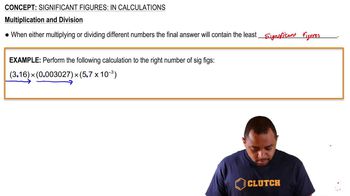Textbook Question
Round each number to three significant figures. a. 79,845.82 b. 1.548937×107 c. 2.3499999995 d. 0.000045389
1035
views
 Verified step by step guidance
Verified step by step guidance



Round each number to three significant figures. a. 79,845.82 b. 1.548937×107 c. 2.3499999995 d. 0.000045389
Calculate to the correct number of significant figures. a. 89.3 × 77.0 × 0.08
Calculate to the correct number of significant figures. b. (5.01×105) / (7.8×102)
Calculate to the correct number of significant figures. d. 453 ÷ 2.031
Calculate to the correct number of significant figures. a. 0.004 + 0.09879 b. 1239.3 + 9.73 + 3.42 c. 2.4 - 1.777
Calculate to the correct number of significant figures. d. 532 + 7.3 - 48.523